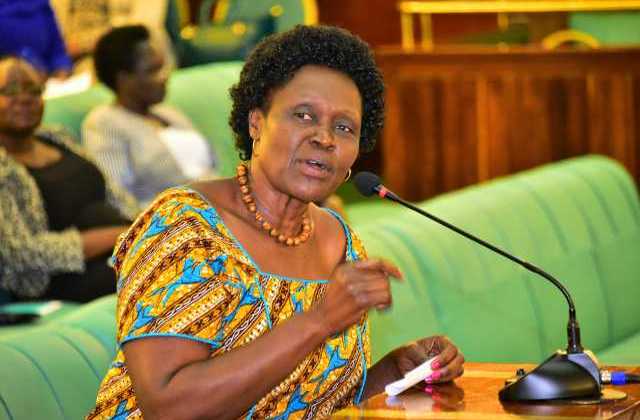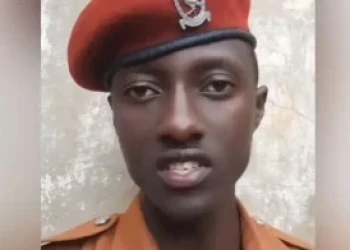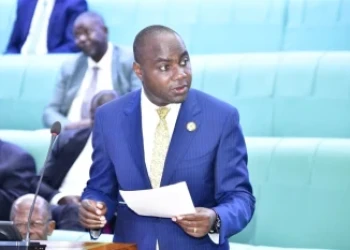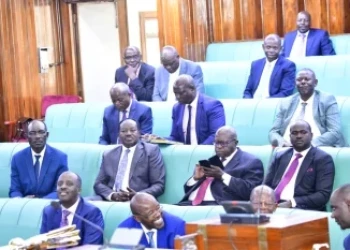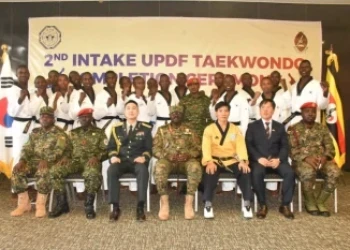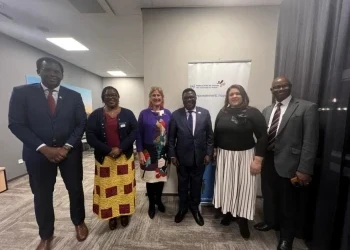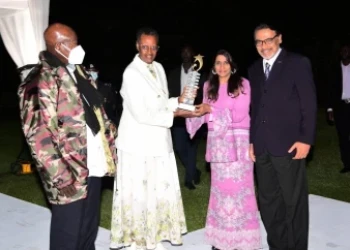Interventions/Commitments | Status at December, 2019 |
- Increase involvement of the population in tree planting through the greening Uganda program by planting 100 million trees.
- Introduce tree planting exercise on all national holidays.
- Step up the supply of free and/or subsidised tree seedlings
- Sensitise and mobilise people to plant trees including those who want to invest in tree planting on a large scale.
- Support private initiatives in production of tree seedlings
| - All public holidays were gazetted for tree planting by Cabinet namely Women's 8th March; Labor Day 1st May; Environment Day 5th June and Youth Day 12th August.
- Others are National/International, Forest, Meteorological, Wetlands and Water Day. Trees will be planted in every district and in all secondary and primary schools.
- NFA has raised over 97,927,130 assorted quality seedlings free and/or subsidized raised and distributed to communities across the country for planting.
|
- Continue to implement a phased approach to sustainable forest management through improving low stocked/or degraded natural forests using the landscape approach, strengthen the policing to protect forest reserves and forts against illegal activities.
| - Over 8,251Ha of tropical high forests restored and over 800,000 hectares of wood land, and tropical forests protected against illegal activities.
|
- Ensure re-surveying and demarcation of external boundaries of 12,000km under 506 Central Forest Reserves (CFRs) with permanent concrete pillars to effectively secure the integrity of the Central Forest Reserves
| - A total 2,752 km Kms external Central Reserve Forest boundary of the 506 CFRs under NFA reopened and marked concrete pillars.
|
- Invest in plantation development at a rate of 2,500 Ha per year while maintaining the existing and subsequent forest crops.
| - At least 43,866Ha for of quality commercial plantations in 5 years has been established and employing over 100,000 people in nursery and tending.
|
- Expanding the forest cover to 20% by 2021
| - The forest cover has increased from 9% (2015) to only 12.4% in 2019 as compared to the manifesto target of 15%. The increase has been due to education, awareness and enforcement as well as restoration through natural regeneration, planting of different species including agroforestry and plantation establishment through projects like Farm Income Enhancement and Forestry Conservation Project, REDD+, Sawlog Production Grant Scheme (SPGS) and Community Tree Planting Programme of the NFA.
|
- Strengthen the policing to protect forest reserves and forests against illegal activities
| - The current EPPU staff stands at 186. These were distributed equally to NEMA, NFA and MWE. The force has supported the sector in protecting against illegal activities in CFRs countrywide. This include illegal charcoal burning in Northern Uganda which is being done with support by NEMA in Kidepo NP and Kalamoja region to protect indigenous wood lots.
|
- Encourage the youth to protect the environment and support youth involvement in green business.
| - There is already an MoU between MWE and Youth Go Green which is involved in most of MWE activities especially advocacy, tree planting, train younger people in climate SMART agricultural initiatives, waste recycling for charcoal briquettes production, awareness creation about climate change, adaptation and mitigation activities, biodiversity conservation and natural resources management countrywide.
- The group has linked the ministry with other youth group in promotion of tree planting and climate chang. It is estimated that an area of 16,200ha has been planted
|
- Continue with demarcating wetland boundaries with concrete pillars and beacons and ensure gazettement targeting 2,880Kms of boundaries of major critical wetlands in the districts of Masindi, Hoima, Arua, Amuria, Kaliro, Gulu, Dokolo, Luwero, Iganga, Mbale, Kibuuku, Sheema, Isingiro, Buyende, Namutumba, Kisoro, Luweero, Budaka.
| - A total of 1,728.5 kms of critical wetlands boundaries have been demarcated with pillars and beacons in Gulu, Lira, Mbale, Bushenyi, Hoima, Jinja, Masindi, Amuria, Kaliro, Buyende, Namutumba, Iganga, Rakai, Sheema, Buhweju, Alebtong, Dokolo, Kisoro, Kabarole, Wakiso, Arua. All the 18 wetland basins have been coded with identifiers to aid gazettement process. For the short term all the wetlands in the Victoria and Kioga basins will be gazette.
|
- Up scale the restoration of at least 19,480Ha of degraded section of wetland to maintain their integrity in Masindi, Hoima, Arua, Kaliro, Gulu, Dokolo, Luwero, Iganga, Mbale, Kibuku, Sheema, Isingiro, Buhweju, Buyende, Namutumba, Pallisa, Kabale, Kisoro, Amuria
| - Restored 10,263.6Ha of degraded wetlands country wide, over the implantation period to maintain their integrity to store carbon in the peat soil and maintain water quantity and quality in the districts of Kumi, Kampala, Kasese, Aleptong, Pallisa, Ngora, Bukedea, Manafwa, Buhweju, Masaka, Jinja, Kamwenge, Masindi, Hoima, Arua, Kaliro, Gulu, Dokolo, Luwero, Iganga, Mbale, Kibuku, Sheema, Isingiro, Buhweju, Buyende, Namutumba, Pallisa, Kabale, Kisoro, Amuria, Kamuli, Buyende, Maracha, Mbarara, Ntugamo, Kiruhura, Kanungu, Wakiso, Kayunga, Lwengo.
|
- Sensitize communities on wise use of Wetlands by up-scaling mobilization and training of local communities on wise use of wetlands by identifying wetland resources for value addition and income generation through development of management plans.
| - Sensitization is one of the key activities being undertaken in the wise use of wetlands and is being promoted in all 136 districts through the District Environment Officer and Wetlands Officers. In addition, the GCF project is covering 20 districts where alternative projects are being promoted such as training 120 beneficiaries in water storage technologies, construction of fish ponds to serve as alternative livelihoods for communities and supplying over 150 Heifers and 600 Turkeys to the community members displaced from Limoto wetland.
|
- Scale up the Municipal Solid Waste compositing facilities
| - Phase I had 9 municipalities of Lira, Soroti, Mbale, Jinja, Mukono, Fort Portal, Kasese, Mbarara, and Kabale. Each received specialized equipment including skip loaders, wheel loaders and a composting plant.
- Phase II was extended to 8 municipalities that include Arua, Gulu, Tororo, Busia, Entebbe, Mityana, Hoima and Masindi. These were supplied with solid waste management equipment like skip loaders, and wheel loaders, while the towns of Arua, Masindi and Hoima have been provided with composting plants.
- A new biogas project was setup in 2018 to support the composting plants to convert Municipal Solid waste into Biogas targeting the three municipalities of Jinja, Mbale and Masaka and Kampala Capital city
|
- Continue with the operationalization of the Environmental Protection Police to enhance compliance monitoring and law enforcement in Forests and Wetlands.
| - The current EPPU staff stands at 186 compared to the desired 350 force required in the short term.
|
- Construction of 12 new large Gravity Flow Schemes in Nyarwodho–Phase II (Nebbi), Lirima–Phase II (Manafwa), Bukwo– Phase II (Bukwo), Bududa-Phase II (Bududa), Bukedea (Sironko, Kween, Kapchorwa, Bulambuli), Ogili (Agago), Ntoroko(Ntoroko), Potika (Lamwo), Bwambara-Bugangari (Rukungiri), Orom (Kitgum), Nyamugasan i(Kasese), Ngoma–Wakyato (Nakaseke).
| - Completed Projects: Nyarwodho GFS-Phase II in Nebbi district, Bududa-Nabweya GFS in Bududa District Phase II, Bukwo GFS in Bukwo District Phase II, Rwebisengo Kanara GFS in Ntoroko District
- Ongoing construction include: Lirima – Phase II (Manafwa) at 93.8%: Bukedea (Sironko, Kween, Kapchorwa, Bulambuli) at 98%, and Orom (Kitgum) at 44%,
- At design and feasibility stage: Bwambara- Bugangari (Rukungiri) detailed design completed; yet to find a source of funds to commence construction; Nyamugasani (Kasese) EIA completed. Construction to commence in FY 2020/2021; Ngoma – Wakyato (Nakaseke) detailed design completed; yet to find a source of funds to commence construction; Ogili (Agago detailed design completed; yet to find a source of funds to commence construction; Potika (Lamwo) detailed design completed. Works to commence in the FY 2020/2021 since funding have since been secured.
|
- Rehabilitate and expand 5 water systems in Nyabuhikye and Kikyenkye (Ibanda), Shuuku and Masyoro (Sheema), Lukalu (Butambala), Bitsya (Buhweju) water systems.
| - Nyabuhikye and Kikyenkye (Ibanda) is at 64%, Shuuku and Masyoro (Sheema) is at 93%, and Lukalu (Butambala) is at 59%, Bitsya (Buhweju) water systems environmental Social and Impact Assessment completed. Construction to commence in FY 2020/2021.
|
- Drill 5,000 boreholes countrywide
| - Out of the annual target of drilling 1,000 boreholes to be fitted with hand pumps based on their yield, a total of 846 hand pump boreholes have been drilled across the country. These boreholes have helped serve an extra 253,800 citizens across the country..
|
- Large diameter wells developed in water stressed parts of the country (50 BH per year) covering Karamoja region, the low-lying, dry expanses of Isingiro, Ntungamo, Kiruhura, Yumbe, Zombo, Koboko, Moyo, Kiboga, Kyankwanzi, Nakaseke, Nakasongola, Rakai, Buyende and Kaliro districts.
| - A number of production wells and large diameter wells have been constructed in different areas (Kalamoja (13), Isingiro(6), Nakasongola (6), Kole (3), Iganga (1), Kamuli (1), Luwero (1), Kitgum (10), Amuru (1), Gomba (1), Lyantonde (1), Mayuge (2), Jinja (1), Arua (1), Omoro (2), Manafa (2), Busia (2), Butambala (2), Kaberamaido (1), Kamuli (2), Wakiso (2), Kiboga (2).
|
- Bulk transfer of water to water stressed areas.
| - Large diameter production boreholes to serve communities in water stressed areas have been constructed in Bugiri and Namayingo districts and has since rolled to Karamoja region and 26 other such districts developing a total of 68 large diameter production boreholes.These are, Karamoja Region Iganga Kole Nakasongola Isingiro Kamuli Luwero Luwero Kitgum Amuru Wakiso Gomba Lyantonde Mayuge Arua Jinja Omoro Manafwa Mbale Lamwo Busia Butambala Kaberamaido Kaberamaido Kiboga Wakiso
|
- Initiate construction of 2,060 boreholes and install with solar powered mini piped water schemes with taps to villages.
| - Completed the construction of 65 solar mini piped water schemes and construction of additional 40 solar mini piped water schemes is ongoing across the country.
|
- Review policy on Operation and Maintenance with a view of Government taking over the role of repairing water sources.
| - The O&M Framework was developed and was due for launching on 24th March 2020.
|
- Complete construction of on-going piped water systems in 19 Towns in Bugongi (Sheema), Bukakata (Masaka), Bukwo, Buliisa, Dokolo, Kagoma (Jinja), Kaliro, Kalongo (Agago), Ocapa & Kyere (Serere), Luuka, Midigo (Yumbe), Ntungamo, Kyalubungu (Isingiro), Nyeihanga (Mbarara), Okoro (Arua), Ovujo (Maracha), Pajule (Pader) and Sanga (Kiruhra)..
| - The target to construct 19 water supply systems in selected towns was completed and target surpassed. So far 36 schemes were constructed to benefit 547,670 people in 40 towns.
|
- 10 new town piped water systems constructed in Kapelebyong (Amuria), Kasagama (Lyantonde), Kayunga, Kinuuka (Lyantonde), Kyamuhunga (Bushenyi), Mpara (Kyegegwa), Nakasongola, Namagera (Jinja), Nyahuka (Bundibujo), Nakapiripirit, Iziru (Jinja), Busede-Bugobya(Jinja), feacal sludge treatment plant (Kamuli).
| - 7 new towns were constructed to completion Kasagama, Kinuuka, Namagera, Nyahuka, Iziru, Busede-Bugobya and Kaperabyong.
- 4 new towns of Mpara Nakasongola, Nakapiripirit under design phase by (IWMDP & STWSSP) projects and Kyamuhunga.
Kayunga is under construction estimated at 85% completion level. - 1 FSM of Kamuli is under construction (98%) completion.
|
- 33 piped water supply systems designed in Aboke (Kole) Buseruka (Hoima), Lwanika (Bugiri), Amuru TC, Buyala (Jinja), Mukura (Kumi), Anyeke (Apac), Kabura (Mbarara), Nakaloke (Mbale), Atapara (Oyam), Kagadi (Kibaale), Namaganga (Jinja),Awach (Gulu), Kal (Lamwo), Namasagali (Kamuli), Baale (Kayunga), Kasanda (Mubende), Nazigo (Kayunga), Bala (Kole), Kikingura (Masindi), Nyabweru (Kisoro), Barakala (Koboko), Kitanga (Kabale), Nyakashaka (Buhweju), Bugobya (Jinja), Kyakabadima (Kibaale), Ofwa (Nebbi), Buhimba (Hoima), Kyenda (Mubende), Rwenshaka (Rukungiri), Buliima (Masindi), Lokung (Lamwo), Wobulenzi (Luwero), Bulegeni (Bulambuli) Kotido, Bulambuli-Buyaga (Bulambuli), Nakiperimoru (Kotido), Kacheri-Lokona (Kotido), Kadungulu (Serere), Kibale (Palisa), Kibaale (Namutumba), Namayingo; ,Barajobi, Olilim & Okwang (Otuke).
| - The 33 towns below are also at various levels of design and construction.
- The 6 were constructed namely Bulegeni Kacheri-Lokona, Bugobya, Bulambuli, Namayingo and Olilim. While Kagadi (70%), Nazigo (20%), Kasanda (18%) and Ofua (60%) are still ongoing.
- The 13 towns have been designed to completion and 5 towns are still under design
- 1 Town is under Procurement: Nyakashaka, 3 Towns not yet designed Mukura, Baale, and Wobulenzi.
|
- Designs for 41 new piped water supply systems to small towns completed in the following towns Amudat, Kambuga, (Kanungu), Namwendwa (Kamuli), Barr (Lira), Namwiwa (Kaliro), Binyinyi TC (Kween), Katovu (Lwengo), Ngoma (Nakaseke), Budaka, Kiwoko (Nakaseke), Nyeihanga Mbarara, Buggadde(Mayuge), Kotido, Bulopa (Kamuli), Kumi/Nyero/Ngora, Okokoro (Maracha), Busolwe (Butaleja), Kyabi (Sembabule),Ovisoni (Arua), Butaleja, Lukaya (Kalungu), Pabbo (Amuru), Buyende, Lumino (Busia), Pacego (Nebbi), Bwondha (Mayuge), Lwemiyaga (Sembabule), Pallisa Gomba, Magodesi (Tororo),Rukungiri municipality, Idudi (Iganga), Musita (Mayuge), Tirinyi-Kibuku, Iki Iki (Budaka), Namagera (Jinja), Zombo TC, Kabwangasi (Pallisa), Namukora (Kitgum).
| - 7 designs completed in towns of Bwondha, Idudi, Musita, Zombo, Ovison, Kotido, Okokoro,
- 15 towns were designs and construction were completed include: Amudat, Kumi-Nyero-Ngora, Namwendwa, Pabbo, Buyende, Pacego, Palisa, Rukungiri Municipality, Namagera, Namukora, Nyeihanga, Kambuga, Namwendwa, Namwiwa, Bulopa
- 3 Designs completed and construction is ongoing: Lwemiyaga (35%), Kiwoko (90%), Binyiny (61%),
- 16 Towns under Designs include: Barr, Ngoma, Katovu, Bugadde, Kotido, Budaka, Butalejja, Lumino, Tirinyi, Kibuku, Ikii-Ikii, Gomba, Magodesi, Lukaya, Kyabi, Busolwe
|
- Extend water pumps to villages
| - 13 large rural gravity flow schemes have been constructed extending water to villages where this technology is appropriate.
These include the new large Gravity Flow Schemes in Nyarwodho – Phase II (Nebbi), Lirima – Phase II (Manafwa), Bukwo – Phase II (Bukwo), Bududa-Phase II (Bududa), Bukedea (Sironko, Kween, Kapchorwa, Bulambuli), Ntoroko (Ntoroko) have been constructed to completion. Construction of Orom gravity flow scheme (Kitgum district) was replaced with six satellite water systems due to inadequate water at Orom hills. Funding for Nyamugasani gravity flow scheme (Kasese) and Bitsya (Buhweju) has been secured and construction will be moved to the period 2021-2026 Manifesto. No funding was secured for Ngoma – Wakyato (Nakaseke) , Ogi etc… |
- Finalise construction of sewerage treatment plant in Bugolobi and attendant sewerage collection infrastructure for Nakivubo and Kinawataka catchment area.
| - Completed construction of 26.7km of sewer mains. The project is expected to serve 2,215,690 people by the year 2033.
|
- Construct 45 public toilets with bathrooms in various location in Greater Kampala.
| - The plan by NWSC to construct 45 public toilets with bathrooms has not yet commenced. This will entail construction of Nalukolongo faecal sludge treatment plant (400m3/d), 240 toilet stances in 17 Government schools and 80 toilet stances in Public toilets.
|
- Expansion of piped water system in Greater Kampala to improve water supply.
- Refurbish Gabba 1 and 2, (Water supply improvement in Namasuba, Ndejje, Lubowa Bunamwaya, Nyanama Kisugula, Kyengera and Nsangi)
- Water network modelling and master planning and re-zoning
- Commence construction works for Katosi Water Treatment plant
- WATSAN improvements in Urban poor areas
| - The Greater Kampala system is under operation
- The project is still at design stage by H.P. Gauff Ingenieure in association with Artelia Eau and Environment and Gauff Consultants (U) Ltd.
- Works commenced, Overall progress of the plant works is 40%.
- Works on staff houses at 90% progress, 12km of pipe laying activities achieved. Commenced construction of Katosi reservoir walls, columns and base for the 1st compartment. Overall progress of the Sonde reservoir is 28%.
|
- Urban poor water service provision- pro-poor interventions through construction of at least 3,000 public stand posts (average 600 PSPs per year in the NWSC operation areas.
| - In the manifesto period 2015-2020, NWSC installed 9,437 new public stand posts (2016-1,129, 2017-1,164, 2018-3,342, 2019-2,172 and 2020-1,630). Total number of PSPs is 19,638.
|
- Continue with the rehabilitation and expansion of the existing water supply and sewerage systems in various parts country for improved service delivery in 10 districts.
- Gulu, Bushenyi, Arua, Mbale (Under the WMDP)
- Masindi/Hoima Albertine Graben Cluster (North)
- Kasese/Fort portal Albertine Graben Cluster (South)
- Mbarara Masaka South Western Cluster.
| - Bushenyi; Project was substantially completed and the water supply systems is under operations. Defects liability period ended September 2018.
- Arua. Project was substantially completed and the water supply systems is under operations. Defects liability period ended February 2019
- Gulu. Works for Karuma intake completed. Rehabilitation of the water treatment plant substantially completed
- Mbale. Development Partner’s No Objection to the evaluation report obtained. The proceeding activities will be done in the next quarter.
- Masindi –Hoima Feasibility and Pre-design is on-going NWSC. NB. Funding for Kasese/Fortportal is not available.
- Mbarara Masaka South Western Cluster
- Inception report submitted. Draft preliminary design review report submitted.
|
- Increase accessibility to water and sanitation services through extension of over 4,000 kms (average of 800km per annum) and Mains Extension of 100 kms of sewer mains
| - In 2016-888Km, 2017-911Km, 2018-2,021Km, 2019-2,728Km
- 1,344km of water mains were extended in the FY 2019/20 (July-December 2019). In manifesto period (2015-21) we have laid 7,892Km of water mains. Current total network is 18,837.12 Km
- During the manifesto period (2015-21), NWSC has laid 105Km of Sewer Mains Extensions (2016-18.5Km), (2017-26.14Km), (2018-24Km), (2019-59Km) and (36Km for 2020).
|
- Create a total of 28mm3 (28 billion litres) of water storage by constructing the following dams: Acanpii dam in Oyam district; Namatata dam in Nakapiripiriti district; Katabok dam in Abim district; Bigasha dam in Isingiro district: Ongole dam in Katakwi district and Mabira dam in Mbarara district.
| - (i) Ongole dam (1,000,000,000 litres) in Katakwi district and Mabira dam (1,100,000,000 litres) in Mbarara completed.
- (ii) Namatata dam in Nakapiripirit district, Bigasha dam in Isingiro district and Katabok dam in Abim district were not implemented because feasibility studies conducted revealed that the geotechnical conditions were unsuitable for construction of dam foundation and required complex and expensive techniques which are not economically viable. Studies are ongoing to find alternative sites for the dams in the areas.
- (iii) Acanpii dam in Oyam district was not implemented because there were land disputes which the District Local Government and the Ministry were unable to resolve.
|
- Designs for the 6 large reservoir with a total capacity of 28bn litres of water storage completed in Acanpii dam (Oyam), Namatata dam (Nakapiripiriti), Ongole dam (Katakwi), Bigasha dam (Isingiro), Katabok dam (Abim) and Mabira dam (Mbarara).
| - (i) Design for Acanpii Dam in Oyam district (2.4 MCM) halted because of land disputes and we could not proceed, (ii) Design OF Namatata Dam in Nakapiripirit district (11.8 MCM) halted because geo-technical conditions rendered the site unviable/expensive, (iii) Design of Katabok Dam in Abim district (2.3 MCM) halted because geo-technical conditions rendered the site unviable/expensive, (iv) Feasibility study for Bigasha Dam in Isingiro district (6.4 MCM) completed, (iv) Construction of Ongole Dam in Katakwi district (1.0 MCM) was completed in 2016 and commissioned, and (vi) Construction of Mabira Dam in Mbarara district (1.1 MCM) in Rwanyamahembe Sub-county commenced in November, 2017 and works are at substantial completion.
|
- Procure construction equipment for large reservoirs to be distributed in Teso, West Nile and Northern Uganda region.
| - Four (4) sets of construction equipment for large reservoirs were procured; Two (2) sets for Teso shared with Eastern region based in Mbale District and two (2) sets shared by West Nile and Northern Uganda are based in Lira District.
|
- Procure additional construction equipment for construction of valley dams/tanks in Buyende, Kaliro, Kayunga, Masindi, Buliisa and Kyegegwa districts.
| - The Ministry has a total of fifteen (15) functional sets of construction equipment that serve at regional basis i.e. North, East, West, Central and Karamoja where the districts of Buyende, Kaliro, Kayunga, Masindi, Buliisa and Kyegegwa access these equipment.
|
- Construction of bulk water supply systems for multi-purpose use in Bukanga (Isingiro), Nyabushozi, Kikatisi, Sanga ,Kanyalyeru and Kazo (Kirihura), Kakuuto and Koochi (Rakai), Kabula (Lyantode), Nakasongola, Nakapiripiriti, Moroto, Katakwi and Amuria districts.
| - Unfulfilled. Feasibility studies were done. Funds for implementation have not been availed.
|
- Undertake detailed feasibility studies and designs of 12 irrigation schemes in Albetong), Namalu (Nakapiripiriti), Mobuku II (Kasese), Amutur (Bukedea), Doho II (Butaleja), Rhino camp; Wadelai (Nebbi/Arua), Biiso (Buliisa), Kateete (Kanungu), Kibimba-Katonga (Gomba/Mpigi/Butambala), Pabo (Amuru),Tochi (Oyam), Musamya (Kayunga).
| - Construction of six (6) medium scale irrigation schemes is ongoing with a total of 3,976 hectares. These include, Rwengaaju in Kabarole District standing at 70%, Tochi in Oyam District standing at 86% completion level, Mubuku-II (480ha) in Kasese District stands at 63%, Doho-II (1,178ha) in Butaleja District is at 80.5%, Ngenge (880ha) in Kween District is 87.5% and Wadelai (1,000ha) in Pakwach district estimated at 53% completion level.
- Design of five (05) earth dams of Kyenshama in Mbarara District, Makokwa and Kyahi in Gomba District, Geregere in Agago District and Ojama in Serere District is ongoing.
- Feasibility studies for fourteen (14) multi-purpose storage dams in Karamoja Sub-region is ongoing. These WfP multi-purpose facilities will also provide water for Irrigation.
|
- Rehabilitate 16 dams in Teso region including Ongole dam
| - Ongole dam (1,000,000,000 litres) in Katakwi district was constructed by MWE. The rehabilitation of 15 old dams in Teso region was not done by the Ministry because of limited financial resources.
|
- Identify areas and provide more water reservoir construction equipment
| - Extra sets of construction equipment were procured and distributed to the various regions for construction of water reservoirs as follows;
- Water for Production Regional Centre West based in Mbarara district with Two (2) units
- Water for Production Regional Centre East based in Mbale district with One (1) unit, and
- Water for Production Regional Centre North based in Lira district with Two (2) units.
|
- Large and medium water reservoirs will be developed for 12 irrigation schemes.
| Large and medium water reservoirs storage for the irrigation schemes was created for; - Olweny (2,800,000,000 litres) in Lira district, Tochi (10,000,000,000 litres) in Oyam district, Ngenge (250,000,000 litres) in Kween district, Wadelai (8,000,000,000 litres) in Nebbi district, and Mubuku II (140,000,000 litres) in Kasese district.
- In addition, the Ministry is conducting Feasibility Studies to identify Mega Irrigation schemes around Mt. Rwenzori area, Mt. Elgon Area and Agoro Hills for potential water reservoirs which will be used as sources of water for irrigation.
- Government has constructed 60 small scale Irrigation schemes in the Districts of Soroti, Abim, Napak, Kaabong, Iganga, Pallisa, Mayuge, Kamuli, Bukedea, Tororo, Katakwi, Amuria, Ngora, Manafwa, Kibuku, Bugiri, Nwoya, Zombo, Lira, Pakwach, Gulu, Omoro, Alebtong, Oyam, Arua, Nwoya, Adjumani, Dokolo, Rukiga, Isingiro, Lyantonde, Mukono, Kiboga, Masaka, Kabarole, Butambala, Gomba, Masaka, Mbarara, Bushenyi, Mbarara, Kyankwanzi, Mityana, Ntungamo, Kalungu, Kagadi, Kisoro, Wakiso, Kamwenge, Kabarole, Kyegegwa and Kasanda. Through this intervention, an additional 617 acres of the country’s irrigation potential.
- Construction of another Seventy (70) Small Scale Irrigation schemes is ongoing in the Districts of Bukwo (1), Kaberamaido (1), Serere (1), Napak (1), Busia (1), Mbale (2), Kaabong (1), Kapchwora (3), Amuria (1), Kayunga (1), Budaka (1), Butebo (1), Soroti (1), Kumi (1), Bukedea (1), Kapelbyong (1), Agago (2), Oyam (1), Nakaseke (1), Pader (3), Omoro (4), Gulu (3), Amolatar (1), Apac (2), Kole (3), Kwania (2), Lira (2), Alebtong (1), Arua (2), Koboko (1), Maracha (1), Moyo (1), Nebbi (1), Yumbe (1), Koboko (1), Ibanda (1), Rukungiri (1), Buhweju (1), Isingiro (1), Rukungiri (1), Kanungu (1), Kyankwanzi (1), Buvuma (1), Hoima (1), Kibaale (1), Kalangala (1), Mpigi (1), Rakai (1), Butambala (1), Kasanda (2), Ntungamo (1), Lyantonde (1), Kyenjojo (1) and Lwengo (1).
- Government is currently undertaking twenty three (23) feasibility studies and detailed designs of medium irrigation schemes and an additional thirty-four (34) Small Scale Irrigation systems (SSIS) in the various Districts across the country.
|
- Connect pumps on some of the existing boreholes with high yields to create multiple points for collecting water from taps
| - Solar water pumping systems have been connected to a total of 128 boreholes to be pumped by solar. This is in addition to the boreholes motorized with electricity from the national grid, serving an extra 198,900 citizens across the country.
|
- Rehabilitate 104 dams in the Cattle corridor
| - Rehabilitation of Ongole Dam in Katakwi district – Construction of Ongole dam in Katakwi District was completed in 2016.
- Rehabilitation of other dams in the Cattle Corridor (104)– The Ministry has constructed Andibo dam in Pakwach District, rehabilitated Ongole and Mabira dams in Katakwi and Mbarara Districts respectively.
- MWE has also rehabilitated valley tanks of Odusai in Pallisa District, Nalubembe in Kibuuku District, Iwemba and Nabweya in Bugiri District, Kyabal and Kalera in Sheema District,
- Constructed nine (9) valley tanks under Kisozi Livelihoods Improvement Project in Gomba and Sembabule Districts.
- Constructed and rehabilitated twenty (20) valley tanks under Global Climate Change Alliance (GCCA) Project in the Districts of Nakasongola, Luweero, Nakaseke, Sembabule, Mubende and Kiboga.
- Constructed 153 valley tanks creating a storage capacity of 458,370m3 using Ministry WfP Equipment in the Districts of Isingiro, Mbarara, Kiruhura, Lyantonde, Tororo, Soroti, Kaberamaido, Bukedea, Gomba, Kabarole, Kamuli, Kiboga, Katakwi, Kitgum, Kyankwanzi, Lwengo, Ntungamo, Sembabule, Kayunga, Nakasongola and Mubende.
|
- Reconstruct Odina Irrigation Scheme in Soroti, Kiige Irrigation Scheme in Kamuli, Rwegaaju Irrigation Scheme in Kabarole district.
| - Rwengaaju irrigation scheme in Kabarole district is under construction (currently at 70% progress) and is to be fully completed by October 2020. The rehabilitation of Odina and Kiige irrigation schemes in Soroti and Kamuli districts was not undertaken because the Ministry was unable to secure funding from the earmarked development partners.
|
- Invest in development of water for industrial purposes by putting in place the necessary infrastructure to support the re-use of water in industries especially in nuclear and oil refining industries which require considerable volumes of water for cooling.
| - Water Supply to Industrial Parks. NWSC has extended water in the constructed industrial parks to improve water supply and avail sufficient water for future developments in the established parks.
- Connected to water by NWSC: Bweyogerere Industrial and Business Park is under the management of NWSC Seeta Branch. Luzira Industrial and Business Park receives water supply from the NWSC Mutungo tank Kasese Industrial and Business Park siting on 70 acres. NWSC provided a DN50mm pipe along the lower boundary of the park and the existing project has been connected and provided with water supply. Soroti Industrial and Business Park sits on 219 acres has been initially connected,
- Not yet connected by NWSC: Kashari Agricultural Land in Mbarara sits on 147.3acres. Mbale Industrial and Business Park Sewerage Services for the Industrial Parks in Mbale preliminary construction process still underwayd. Kapeeka Industrial and Business Park: NWSC in the process of designing a water supply system expansion project Karamoja Industrial and Business Park is till at design stage and not yet connected to NWSC. Jinja Industrial and Business Park,
- Sewerage Services for the Industrial Parks in Mbale still at design level.
|
- Avail machinery for construction of valley dams /tanks and for drilling boreholes where borehole usage is appropriate to ensure availability of water for the animals and irrigation
| - Machinery for construction of valley tanks/dams: The Ministry has a total of 15 functional Sets of construction Equipment distributed in the regions of North, West, East, Central and Karamoja. To date, a total of 1,197 valley tanks have been constructed under this arrangement.
|
- Re-locate communities living in or near fragile wetlands and slopes that are prone to landslides
| - The Building Resilient Communities, Wetland Ecosystems and Associated Catchments project in Uganda is providing alternative livelihood to communities within wetland ecosystems as means to adopt to climate change impacts.
- Furthermore, under the Inclusive Green Growth for Poverty Reduction, feasibility studies for the landscape restoration on Rwenzori is being undertaken to inform the restoration intitives to be undertaken on fragile areas.
|
- Continue to de-silt and clean drainage areas across the city as a way of promoting public health
| - MWE works through KCCA to maintain all primary, secondary and tertiary channels in Kampala. MWE provided excavator tractors, backhoe loaders and tipper trucks for routine maintenance of drains in Kampala. In addition to the mechanized desilting, a team of over 500 casuals workers desilt the city drains every day, removing (over 2100 tons/month of) garbage and plastics etc. from drains. KCCA has established a new plastic recycling plant at Bugolobi (near NWSC sewerage plant). The aim of this initiative is to reduce dumping of plastics in the drains by making plastic recycling commercially attractive.
|
- Support planting of trees for commercial purposes and complementary timber export value-addition activities
| Over 6million assorted tree seedlings distributed and planted for commercial purposes. 7,000 hectares of forest cover restored on private and degraded lands through planting of trees. The request for support interms of seedlings is overwhelmingly high and There has been an increasing desire to export timber products legally by the private sector including Plywood manufacturing companies, Wood carving cottage industries, timber among others, recommendations for export to the Ministry of trade and Cooperatives exceed 650 cubic meters of wood. |
- Complete demarcation and gazetting of all wetlands and fragile eco-systems in the country
| Critical wetland ecosystems that were under great threat of encroachment and degradation were identified and earmarked for restoration and demarcation, to ensure that their integrity was maintained. From 2016 to date, MWE has demarcated over 887.9Km wetland boumdary in Pallisa, Arua, Gulu, Amuru, Maracha, Lira, Hoima, Masindi, Buwheju, Bushenyi, Mbarara, Mbale, Namutumba, Wakiso, Mukono, and 60km of River Nile buffer zone in Jinja, Kayunga and also restored over of 1,535ha of critical wetlands in Mbarara, Kiruhura, Aleptong, Dokolo, Lira, Pallisa, Kumi, Kampala, Wakiso, Kayunga, Lwengo, Masaka, Sheema to secure their ecological and biodiversity integrity. The process for gazettement of wetlands across the country was initiated to raise their conservation and protection status and therefore support enforcement and compliance. MWE embarked on coding of wetland in preparation for gazettement. Coding is giving a unique identifier e.g. number followed by names. Each drainage basin has a code from 01 to 10. So far all the 8 drainage basins have been coded. Preprartion of the gazttement instruments has been intiated and will begin with the 12 RAMSAR site and the dermacated wetlands. |
- Promote protection of wetlands through sustainable use by communities for making of handcrafts, nature-based fishing and tourism
| The MWE through the Wetland Management Departmnet has continued to protect wetlands through sustainable use by communities. MWE in collaboration with the UNDP secured funding from the GoU and the Green Climate Fund to support communities living near wetland ecosystems to have altenertive livelihoods and improve their standards of living. To this effect, a project (Building Resilient Communities, Wetland Ecosystems and Associated Catchments in Uganda) was developed and approved and is currently in its second year of implementation. To date, the project has trained 120 beneficiaries in water storage technologies such as ground water and rain water harvesting and storage in the districts of Bushenyi, Sheema, Buhwezu, Kanungu and Mitooma, Ntungamo, Kabale, Kisoro, Kanungu, Rubirizi and Rukungiri; constructed small scale solar powered irrigation schemes in Eastern Uganda in Limoto wetland, Pallisa district to provide water for production to communities neighbouring the wetland; Constructed 5 fish ponds and stocked them with 75,000 fingerlings to serve as alternative livelihoods for communities who were removed from Limoto wetland, supplied 150 Heifers and 600 Turkeys to the community members displaced from Limoto wetland. The alternative livelihoods have culminated into the restoration of 50ha of the degraded sections of Limoto wetland. The GCF project is a pilot project covering 20 districts (Ntungamo, Kabale, Kisoro, Rubirizi, Rukungiri, Bushenyi, Sheema, Buhweju, Kanungu, Mitooma, Bukedea, Ngora, Tororo, Pallisa, Butebo, Bugiri, Ngora, Kumi, Kibuku and Namutumba) so far. |
